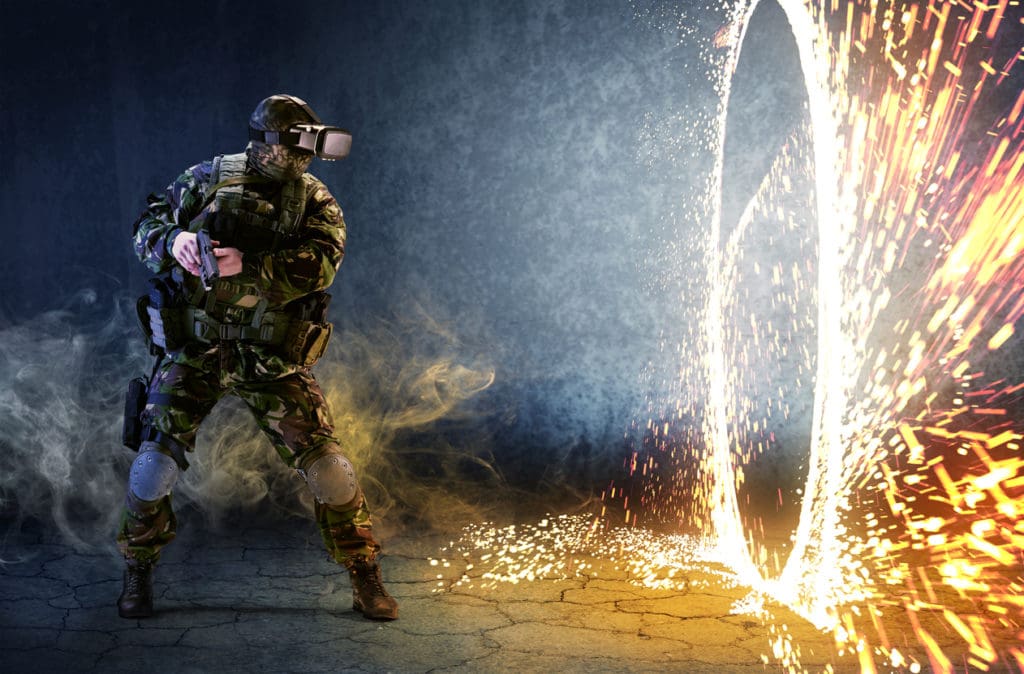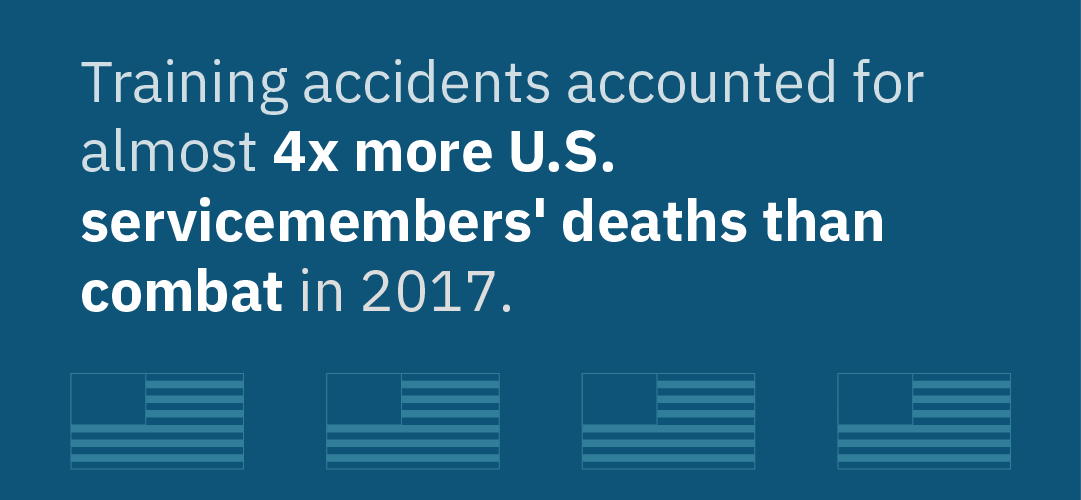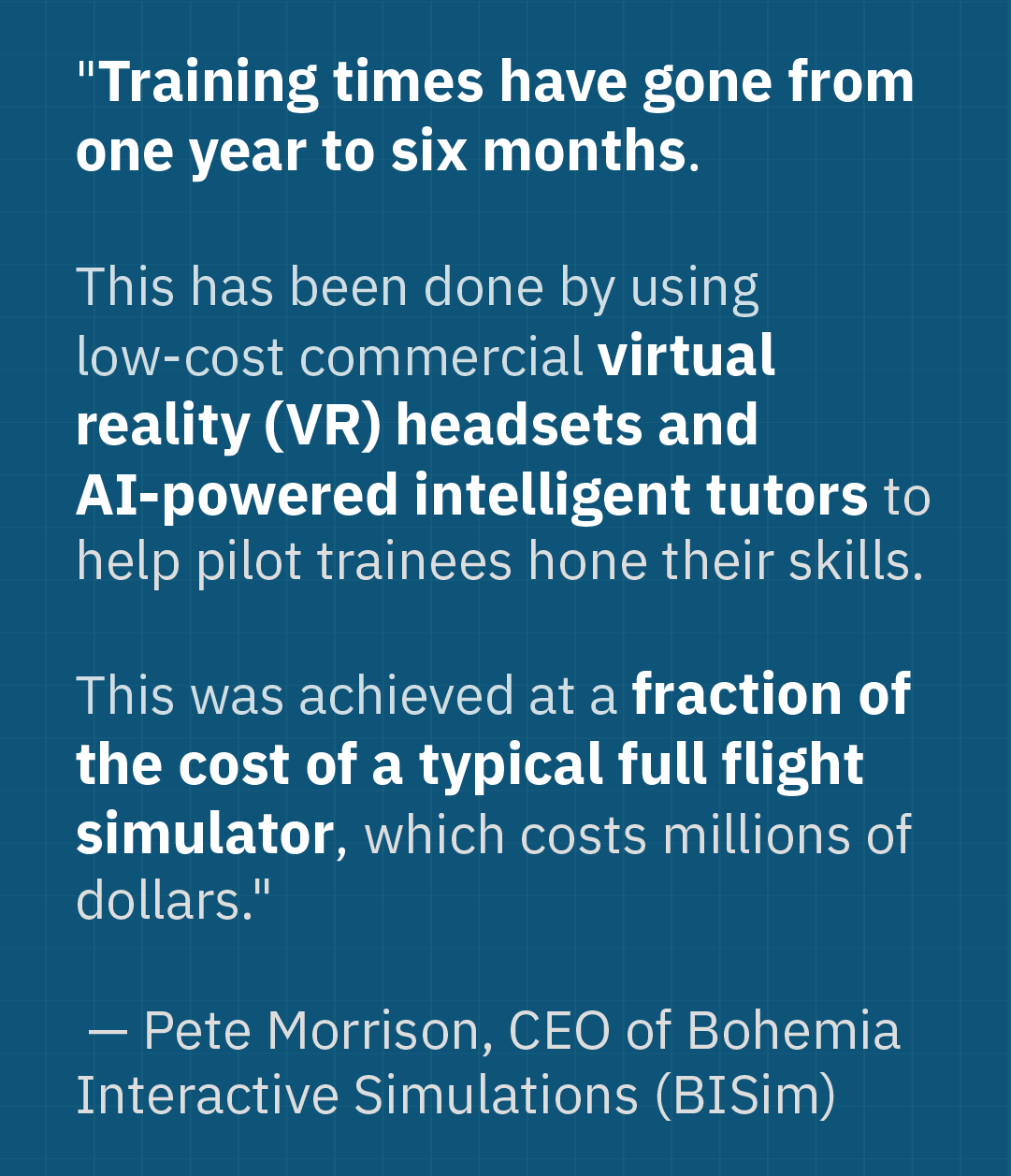You may be aware that the military uses “war games” to train its personnel, but what exactly is military training simulation software, and how can recent advancements in artificial intelligence improve it? Broadly speaking, military simulations can refer to a wide range of training methods. Militaries have used everything from mathematical models to comprehensive rehearsals of strategies and weapons in a non-combative environment to prepare servicemembers. In particular, military training software is a frequently used type of military simulation, because it is often the best way to mimic real-life combat situations while keeping both injury risks and operational overhead low.
Military training simulation software can become even more beneficial by incorporating artificial intelligence. Keep reading to learn how our military can use AI in simulations to its advantage and how Sentient Digital, Inc. is developing innovative new software to leverage this opportunity.
THE ROLE OF VIRTUAL MILITARY TRAINING SOFTWARE

The U.S. Army has employed virtual reality software to train its soldiers for many years. Our military has used virtual reality technology for training, simulation, and even therapy much longer than VR has been used commercially. Software-based training programs tend to cost less money, which is just one reason why the army has favored them for so long.
Perhaps more crucial to their popularity in the military, virtual reality environments embody the Army motto: “Fight as you train, train as you fight.” In other words, virtual realities can best mirror the realities of warfare—without actually endangering servicemembers.
Virtual reality environments help members of our armed forces understand how to work with their teammates, handle mock weapons of the exact same size and weight as their real-life counterparts, and learn to make good decisions under high-stress situations.
Having military training simulation software programs mimic real-world combat as closely as possible is critically important. While the average consumer of VR products simply enjoys the heightened technology, it’s not an overstatement to say that for soldiers, realistic virtual training environments could have life-or-death consequences. Being unprepared during combat—whether because of walking new terrain, facing an unfamiliar weapon, or having a drill fail to work as it did in training—can result in dire injuries or even death for a soldier or their comrades.
And it’s not just combat that can be dangerous to armed servicemembers, but also the training process itself. In fact, a recent congressional report revealed that more U.S. troops had died during training exercises than in combat. While the exact reasons for this are still being discussed among military experts, the net result is that our military is looking more closely at safer ways to implement training procedures, such as increased application of virtual environments.
How Can AI Train Military Personnel Better and Save Lives
More recently, artificial intelligence presents our armed forces with opportunities for even more benefits to military training software. Artificial intelligence can introduce more unpredictability, challenge, and realism, to create a better training experience. Learn more about how military training simulation software can benefit from increased AI functionality below.
AI-based military simulations provide a highly detailed training environment, significantly improving the combat readiness of soldiers and potentially saving lives on the battlefield. These simulations can include realistic scenarios, opponents that can learn and change their behavior, and data analysis to show where additional training may be needed. Developing soldiers’ skills in a safe environment makes them better equipped to take on complex and quickly changing combat situations, ultimately decreasing the risk of casualties in real-world operations as well as in training accidents. AI-driven military simulations enhance the skills that empower military personnel to make the split-second decisions they will need to make in a real-world situation, with implications for national security and the potential to save lives.
Advantages of Military Training Simulation Software with AI

Read more about each of these advantages below! You can share our infographic on social media or copy and paste the code below to embed it on your website:
<img src="https://imgur.com/LprVQWN">
<p>Advantages of Military Training Simulation Software with AI - An infographic by the team at <a href="https://sdi.ai/">Sentient Digital, Inc.</a></p>
1. Military personnel can train in more realistic simulated settings.

Until recently, realistic training settings were one demand that even virtual reality technology struggled to fulfill. While settings could be made to look naturalistic, it was difficult to make the virtual world actually mimic a real-life place rather than, for instance, generic Middle Eastern mountain ranges.
However, a new military training simulation software program can recreate real cities in virtual environments. Now, instead of only having broad knowledge of what forests in Asia might look like, soldiers will have already trained in these exact environments before they ever set foot in the real locations. Such highly specific knowledge will enable soldiers to move more quickly through the real environment, be more accurate with their logistical planning, and prepare themselves better ahead of time.
This virtual reality program is able to generate these Synthetic Training Environments (STEs) quickly and accurately with the help of AI. Locations halfway around the globe can be created within a matter of minutes by gathering information such as satellite imagery, street-view data, and even 3-D images taken by drones. The AI software can gather this data and use it to recreate the details of the landscape.
What’s more, this technology has the ability to update training environments with new data. Let’s say that a particular city within the AI program expands in real life. The system can be easily updated with the help of AI to incorporate this new information. This allows soldiers to experience the terrain as it exists now, as opposed to several months or even years ago.
2. AI MILITARY TRAINING SIMULATION SOFTWARE SAVES TIME AND MONEY.

People often think that artificial intelligence has a high operational cost, simply because it is cutting-edge technology. However, AI actually tends to save organizations money in the long run, as has been the case for both UPS and IBM, among many others. The recent generative AI revolution has made AI directly accessible to the general public and demonstrated that the technology can have a huge impact with minimal initial investment.
While startup costs of implementing AI technology often can be higher at first, artificial intelligence is more efficient at certain tasks than humans are. AI, for instance, can synthesize large amounts of data and perform warehouse tasks faster than us, allowing humans to focus on tasks for which their skills are more suited, while also ensuring that we can make data-driven decisions more easily.
When it comes to our armed forces, planning and executing full rehearsals of military exercises typically requires more financial resources than military training software. Even classroom training can be more costly, in terms of both time and money. Its higher expense comes from the need for a large number of physical assets in a single place at the same time.
With cost evaluations, it’s important to look not just at the sticker price, but also at the operational costs. In the case of our Air Force, training pilots on AI flight simulations actually helps them move onto their training within real aircrafts faster. These simulations offer pilots more intimate knowledge of combat flying than if they had only taken notes, enabling them to get the training they need swiftly and safely.
3. Artificial intelligence can best replicate the many variables of combat.
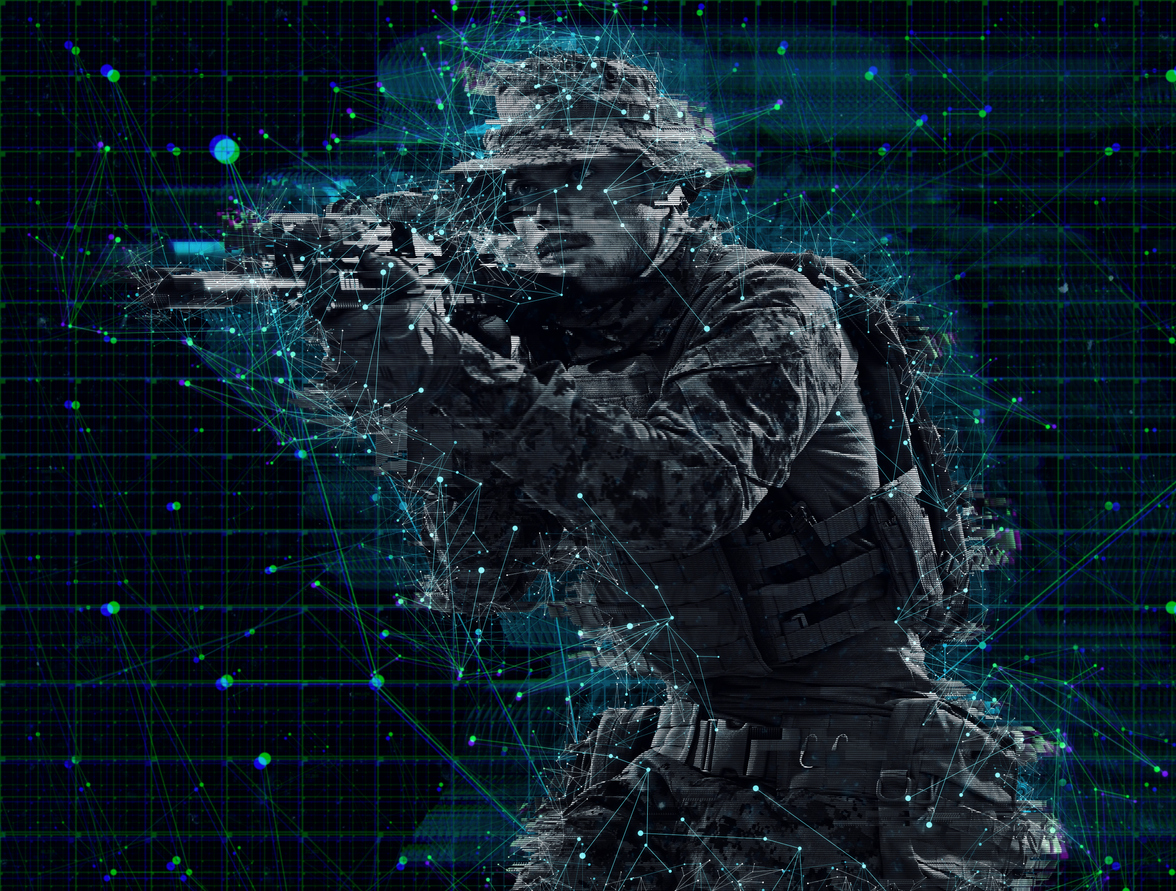
Modern warfare has become increasingly complex over the last few decades, and not just when it comes to high-tech traditional weaponry. Megacities and other complicated environments, as well as electronic warfare and cyberwarfare, create new challenges for our troops. As warfare has become more complicated, so too has the need for military training that is more multidimensional.
Hybrid threats, such as economic attacks and data harvesting, combine conventional warfare with cyberwarfare and other nontraditional strategies. Soldiers must be trained to fight in a wide variety of landscapes, using a range of equipment and strategies, in order to be prepared for hybrid warfare.
Additionally, military personnel need to understand the socio-political climate of the location where they’re based. This knowledge can better prepare them to interact effectively with the local population, as well as strategize regarding their specific enemy in the region.
So how do these factors relate to artificial intelligence and military training simulation software? AI programs with the ability to create a multitude of intelligent, autonomous agents can better replicate future interactions with allies, enemies, and local civilians.
These agents can be used to create immersive, realistic simulations that span a variety of hybrid warfare tactics along numerous socio-political spectrums. Since AI gives the agents autonomy, they will not behave in predictable patterns that soldiers could potentially detect after multiple training sessions. Rather, each simulation will reset that particular agent’s behavior pattern.
AI technology is especially valuable for its ability to incorporate an element of unpredictability into military training simulation software. A crucial part of excelling in warfare is being able to think fast on one’s feet, be that with a gun in hand or during a simple exchange with a local civilian. Having armed servicemembers already trained in this skill prior to actually stepping into combat allows them to be more effective once they actually deploy.
4. AI MILITARY TRAINING SIMULATION SOFTWARE CAN TEACH US NEW WARFARE STRATEGIES.

As previously mentioned, there are numerous tasks that AI can perform better than humans. Many involve data analysis. However, our abilities as humans to abstract, generalize, reason, learn, plan, and intuit—all skills that come into play in a combat environment—currently exceed the abilities of AI creations.
Effective military tactics also depend on an understanding of spatial and temporal elements. While these concepts come naturally to humans, they must be programmed into AI. But what if there were an AI system that could learn enough from humans to show us novel, innovative strategies?
At Sentient Digital, Inc., our senior AI research scientist and team have worked to develop an AI program capable of playing against—and defeating—an expert human opponent in an operational-level modern wargame. Our multi-agent military training simulation software works in a way similar as Alpha Go, a reinforcement learning program created to master the board game Go.
Alpha Go has succeeded in not only besting the former world champion of Go, but furthermore repeatedly making moves that Go experts do not initially understand. In other words, Alpha Go is a program that manages to not only win every time, but also slowly teaches its human audience and players a new way of comprehending the game.
It is our goal to design AI military training simulation software that produces these kinds of results. Many members of our team, including senior staff, possess both hands-on military experience and AI expertise. This puts us in a uniquely qualified position to understand our military’s real-world needs, as well as deliver a practical and effective technology solution.
We have worked to establish an AI system that will ultimately utilize its vast computational abilities in combination with observed behaviors of expert human players. Through this process, we believe our AI will become not only a worthy opponent in military simulations, but an opponent that can teach us how to improve our real-life combat strategies.
A Significant Recent Development: The Proliferation of Generative AI
Generative AI, as the name suggests, is a type of artificial intelligence that focuses on generating content, which can include text, images, and videos. Using machine learning techniques, particularly neural networks, it can create content that appears human-made. One of the most exciting recent developments in generative AI is the proliferation of applications into which the user inputs prompts and the application generates content in response. Using NLP, the human and AI can essentially have a conversation, meaning that one no longer needs to be a computer scientist to benefit from generative AI’s capabilities.
When it comes to military simulations, generative AI can significantly enhance their realism. It can simulate complex scenarios set in realistic environments, but it can also create more lifelike opponents and produce human-like communication such as via intelligence reports. Generative AI can also communicate data insights in natural language and respond to questions, making it easier for commanders to see what their subordinates are learning from the training and determine where further training may be needed.
How Generative AI Improves Military Simulation Software
One of the most significant recent developments in AI is the explosion of generative AI. Now widely available to the general public, generative AI has many national security implications, so leveraging the technology for military training simulation software makes sense. Generative AI can greatly enhance military simulations by improving their realism, scalability, and adaptability. Here are some examples:
More Realistic Simulations
AI can now create lifelike imagery and environments for wargames and other military simulations. As simulations more accurately replicate conditions, the preparation they offer to military personnel will improve and the value of the simulation will increase.
In addition to visuals, the text generated by AI can mimic humans’ tone of voice and be tailored to specific purposes. This enhances the user experience through natural language communication.
More Challenging Opponents and Scenarios
An important aspect of military simulations is the realistic nature of the danger that users face. In real life, an enemy can learn from a soldier’s actions and change tactics in response. Generative AI can adapt its behavior and create a more challenging and realistic experience. This real-time adaptability is one of the major strengths of generative AI for military simulations. The more realistic the simulation, the better it can prepare personnel for real-world opponents.
Similarly, the scenarios that generative AI can generate are potentially much more realistic situations than those previously possible. This ensures that training exercises remain unpredictable and challenging, encouraging the user to devise innovative new responses. This provides valuable training for the unexpected situations that occur on the real battlefield.
Practical Considerations
Despite the initial investment to create virtual training, over time it can be much less expensive than physical military training exercises, which can include such costs as fuel and vehicle maintenance. Setting up and carrying out training exercises may also involve a significant investment of time and the attention of personnel, taking them away from other tasks. However, an argument could be made that military simulations do not adequately replicate real-world conditions, so the additional cost, time, and personnel attention are worth it. Generative AI is narrowing this gap by increasing the realism of simulations, potentially saving military resources.
To demonstrate the ROI of military simulations, generative AI can collect, receive, and analyze a great deal of data. This can include data about how well particular users perform on specific tasks and about how the unit as a whole performed. Using NLP, the AI can communicate this information in a conversational format with military commanders, identifying areas where personnel may need additional training or support. The commanders can ask the AI questions about the data that will clarify how well the simulation is working to enhance their subordinates’ skills, and use the AI to generate reports to provide to decision makers higher up in the military.
Another convenient aspect of AI military simulations is the ability to conduct training remotely, allowing military personnel to participate in realistic simulations from different locations. With generative AI, the experience of this remote training can be much more realistic, so again quality does not have to be sacrificed in the name of other goals such as the potential to conduct remote training.
Generative AI has the potential to enhance military simulations in a variety of ways. From more human-like communication to more lifelike opponents, generative AI builds on the history of AI wargaming to take these simulations to another level. This is an exciting new frontier in AI for military simulations, and Sentient Digital is fully embracing it.
Sentient Digital’s Exciting Recent Contribution to Military Simulation Software: Fleet Emergence
Sentient Digital develops military training simulations powered by AI. Our naval wargaming simulation, Fleet Emergence, is a good example of how AI can provide realistic military simulations.
Fleet Emergence leverages Large Language Model (LLM) AI combined with Artificial Cognitive Intelligence (ACI). This allows it to realistically simulate threats and countermeasures, as well as convincing human communication. With three available scenarios, Fleet Emergence allows naval commanders to experience and practice formulating responses to potential real-world situations in a realistic Operational Environment.
Key features of Fleet Emergence include:
- Natural Language Interface
- Dynamic Scenario Generation
- Real-time Communication & Reports
- Adaptive Opponent Behavior
These components allow Fleet Emergence to receive inputs in natural language from the participant, essentially meaning they can talk to the AI the same way they would talk to a person. Additionally, it can create complex scenarios that incorporate historical context. It can also communicate with the user in realistic ways, including imperfections in its reports to simulate the consequences of incomplete information during a real event. Significantly for training purposes, Fleet Emergence can mimic the way an opponent would respond to the user’s actions, including learning from behavioral patterns and changing its own behavior accordingly.
Ultron Emergent and Emergent Swarm
Sentient Digital has also created military simulations dealing with the potential of drone swarm intelligence. Swarm intelligence is an emergent property, meaning that a swarm of drones may exhibit a kind of collective intelligence that is in addition to the intelligence of each member of the swarm. Ultron Emergent provides an initial option to replace the live training exercises the military was conducting to study the potential and the threat of swarm intelligence in groups of unmanned vehicles in an urban setting.
The successor of Ultron Emergent is Emergent Swarm. This simulation models swarm intelligence of unmanned vehicles while also simulating manned vehicles, across multiple environments. The AI also generates data about the behavior it observes and reports on it.
Red Emergence
Sentient Digital’s Red Emergence simulates state-of-the-art Russian military tactics to create a highly realistic opponent in wargame scenarios. It uses NLP to analyze military doctrine from texts and incorporate it into its scenarios, creating a challenging opponent that uses real-world military techniques.
By continuing to develop highly advanced simulations, Sentient Digital contributes to the forefront of military training for the modern world. Using our capabilities in artificial intelligence we endeavor to support the warfighters of the today and help to develop the warfighters of the future.
MORE WAYS AI IS REVOLUTIONIZING THE MILITARY
AVIATION MAINTENANCE

Military aviation maintenance is a vital aspect of missions, training, and programs. Commercial AI programs can be utilized by aviation engineers to help predict when an aircraft needs repairs or when certain parts need replacement.
AI can improve the maintenance procedures’ overall efficiency, allowing more aircraft to be available for missions. AI technology can also be used during the design process to develop more advanced aircrafts for the future.
AI SENSORS
AI sensors detect changes in the surrounding environment and convey data about those changes in a way that’s comprehensible to humans or to another machine. AI sensors collect data more quickly and gather results with greater accuracy than humans can. This enables military operatives to make quick, data-based decisions in combative or otherwise sensitive environments.
At Sentient Digital, Inc., we’re working on an AI program that gathers data about a hostile target from a variety of sources, including human intelligence as well as air, ship, and land radar sensors. The AI fuses this data into a Common Operational Targeting Picture, then determines the best weapon and platform for attacking the target. Finally, the program identifies the assets most suitable for attacking the target and contacts them.
AI sensors can also connect to the Internet of Things (IoT), which enables communication between devices on a digital network. The Internet of Military Things (IoMT) is becoming increasingly important for the combat operations of the armed forces, such as reconnaissance, surveillance, and digital warfare. AI sensors connecting to the IoMT can ultimately reduce the physical space and high cost that digital operations require in a combat environment.
NATURAL LANGUAGE PROCESSING (NLP)
The military can utilize natural language processing and AI to automatically classify and match incoming data to monitored indicators and warnings. NLP involves computers deriving meaning from human language, essentially allowing humans to communicate with computers in the way that they normally speak. In a military context, NLP can analyze communications to determine whether they indicate a threat, for example. NLP can also provide alerts on keywords or themes that indicate emerging tactics, procedures, combat techniques, or trending topics.
TARGET RECOGNITION
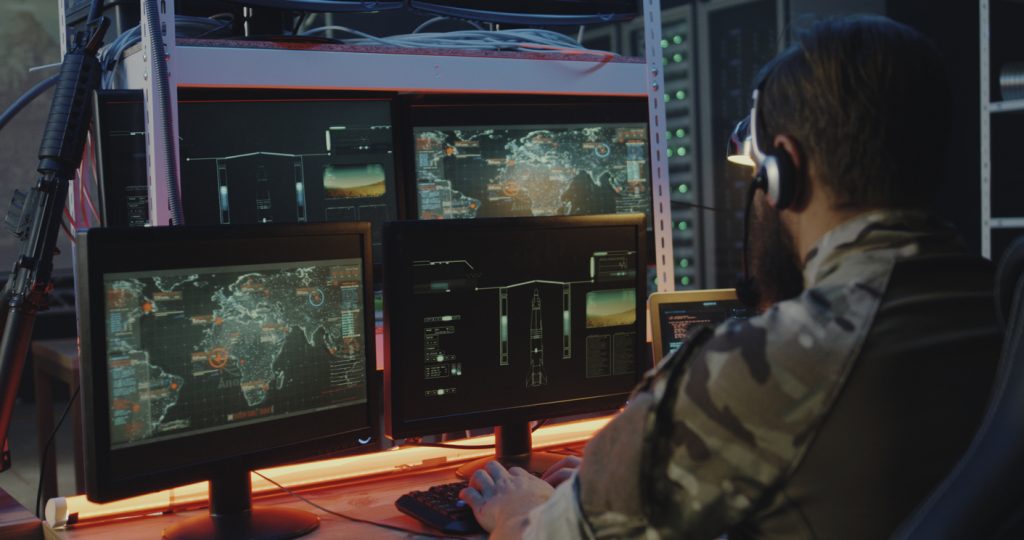
AI can be used to enhance the accuracy of target recognition in complex combat environments. This allows defense forces to gain a deeper understanding of potential areas of operation, including the analysis of reports, documents, newsfeeds, and other forms of unstructured information.
AI target recognition can also include enemy behavior based on probability forecasts, aggregation of weather and environmental conditions, anticipation, flagging potential supply line bottlenecks or vulnerabilities, assessments of mission approaches, mitigation strategies, and the discovery of new targets.
THREAT MONITORING AND SITUATIONAL AWARENESS
Threat monitoring and situational awareness rely heavily on intelligence, surveillance, and reconnaissance operations (ISR), which acquire and process information regarding various activities. Equipping this system with AI can assist defense personnel in threat monitoring, which will, in turn, enhance their situational awareness.
Unmanned aerial vehicles (UAVs) enabled with AI, also known as drones, can be effectively used to patrol areas, identify potential threats, and transmit information about the appropriate response team’s perceived threats. UAVs can strengthen the security of military bases and increase personnel’s safety and efficacy in both battles and at remote locations.
INFORMATION PROCESSING
AI can efficiently process large volumes of data for valuable information and relay important information quicker. Additionally, AI can assist in the culling and aggregating of information from different sources. This provides the military with advanced analysis, including recognized patterns and correlations.
Using AI for information processing also helps prevent human error or disregard of potential threats. AI can both process and analyze information more rapidly than humans, but also can work for longer periods of time, further facilitating its quicker identification of potential threats.
CONTACT Sentient Digital FOR YOUR AI SOLUTIONS
AI has recently become more important than ever before, permeating all industries and sectors. Your agency or business needs to adopt AI to keep pace, but needs to do so in a way that furthers your goals and will show a return on investment. As a technology solutions provider on the cutting-edge of artificial intelligence software, Sentient Digital is well prepared to help your organization create, refine, and implement AI technology to meet your needs.
We, along with our subsidiary, RDA, also provide a wide variety of IT services and software development for defense, government, and commercial clients. Our other specialities include systems engineering and cybersecurity, and we pride ourselves on delivering high quality solutions for our clients.
Contact us today to learn more about how we can create state-of-the-art technology solutions for you.

